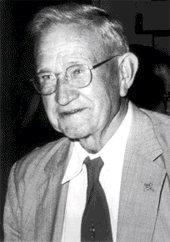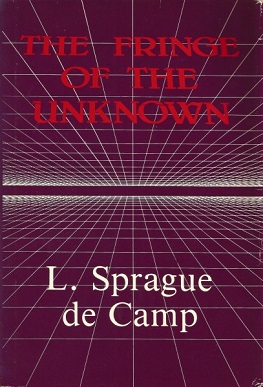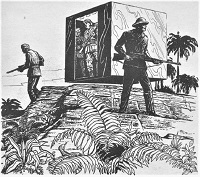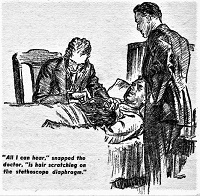Plot summary
Vernon Brock, an assistant aquarist at the New York City Aquarium, has, in addition to his normal duties, been studying the properties of gills and lungs, and devised a theoretical method of inducing the latter to assume the properties of the former. He believes the vapor given off by a mixture of "halogen-bearing organic compounds" would do the trick, and intends to experiment on its effect with alligators. Unfortunately, the flask containing the solution breaks, giving Brock himself a whiff of the vapor.
Overcome, Brock falls into a shark tank. He quickly discovers that he can now "breathe" in water but not in air. There are difficulties: the higher density of water makes the breathing process slow and laborious, normal speech is rendered impossible, the liquid environment is too cold for his body, and he tires easily, since his lungs cannot extract as much oxygen from the water as his metabolism is used to.
Soon Brock's colleagues gather above the tank. Knowing of his experiments, they realize what has happened and do their best to help him. He interacts with them initially by sign language and then by using a remora to scrawl a message on the glass of the tank. He requests two weighted stepladders and a weighted plank. Placing the plank across the ladders, he lies down atop it so that he is just beneath the surface of the water and by extending his hands into the air can communicate further by writing on a pad of paper. He is brought food and finds that with some care he can eat—though not meat, as the sharks quickly steal it. Instead he subsists on bananas. Meanwhile, a crowd of the public has gathered in front of the tank, including a little man who observes Brock with a "peculiar intentness" he finds disturbing.
For Brock's comfort, the temperature is raised in the tank, more air lines are run in to increase the available oxygen, and the sharks are moved to a reserve tank. Nonetheless, he spends an uncomfortable night, unable to sleep "because of the constant muscular effort required to work his lungs." His thoughts grow confused, and he becomes delusional. He also starts feeling that his lungs are not working right. In the morning, the little man returns, feeding his confusion and growing paranoia. Believing himself a fish and that the man wants to eat him, he attacks the glass with his pocket knife until it gives way and he and all the water spill out onto the concourse.
Brock wakes up in the hospital, having been mercifully unconscious during the period in which his lungs finished returning to normal. While recovering well, he learns that the aquarium is facing a lawsuit from the little man, Oscar Daly, who nearly drowned when he let the water out of the tank. After his release, however, Brock comes to an arrangement with Daly that persuades the latter to drop his suit. Instead, Daly, a former circus acrobat, will use Brock's discovery to exhibit himself for money as Oscar the Merman.

Edward Elmer Smith was an American food engineer and science-fiction author, best known for the Lensman and Skylark series. He is sometimes called the father of space opera.

Lyon Sprague de Camp was an American author of science fiction, fantasy and non-fiction literature. In a career spanning 60 years, he wrote over 100 books, both novels and works of non-fiction, including biographies of other fantasy authors. He was a major figure in science fiction in the 1930s and 1940s.

Unknown was an American pulp fantasy fiction magazine, published from 1939 to 1943 by Street & Smith, and edited by John W. Campbell. Unknown was a companion to Street & Smith's science fiction pulp, Astounding Science Fiction, which was also edited by Campbell at the time; many authors and illustrators contributed to both magazines. The leading fantasy magazine in the 1930s was Weird Tales, which focused on shock and horror. Campbell wanted to publish a fantasy magazine with more finesse and humor than Weird Tales, and put his plans into action when Eric Frank Russell sent him the manuscript of his novel Sinister Barrier, about aliens who own the human race. Unknown's first issue appeared in March 1939; in addition to Sinister Barrier, it included H. L. Gold's "Trouble With Water", a humorous fantasy about a New Yorker who meets a water gnome. Gold's story was the first of many in Unknown to combine commonplace reality with the fantastic.
The 1st World Science Fiction Convention (Worldcon) was held on 2–4 July 1939 in the Caravan Hall in New York City, United States, in conjunction with the New York World's Fair, which was themed as "The World of Tomorrow". It was later retroactively named "NyCon I" by Forrest J Ackerman.

Peter Schuyler Miller was an American science fiction writer and critic.
Robert Edward Weinberg was an American author, editor, publisher, and collector of science fiction. His work spans several genres including non-fiction, science fiction, horror, and comic books.

The Fringe of the Unknown is a science book by L. Sprague de Camp, first published in hardcover and paperback by Prometheus Books in 1983.

The Queen of Zamba is a science fiction novel by American writer L. Sprague de Camp, the first book of his Viagens Interplanetarias series and its subseries of stories set on the fictional planet Krishna. It was written between November 1948 and January 1949 and first published in the magazine Astounding Science Fiction as a two-part serial in the issues for August and September 1949. It was first published in book form as a paperback by Ace Books in 1954 as an "Ace Double" issued back-to-back with Clifford D. Simak's novel Ring Around the Sun. This version was editorially retitled Cosmic Manhunt and introduced a number of textual changes disapproved by the author. The novel was first issued by itself in another paperback edition under the title A Planet Called Krishna, published in England by Compact Books in 1966. A new paperback edition restoring the author's preferred title and text and including the Krishna short story "Perpetual Motion" was published by Dale Books in 1977. This edition was reprinted by Ace Books in 1982 as part of the standard edition of the Krishna novels. The novel has been translated into German, French, Italian, Czech, and Polish. An E-book edition was published by Gollancz's SF Gateway imprint on September 29, 2011 as part of a general release of de Camp's works in electronic form.

The Best of L. Sprague de Camp is a collection of writings by American science fiction and fantasy author L. Sprague de Camp, first published in hardback by Nelson Doubleday in February 1978 and in paperback by Ballantine Books in May of the same year as a volume in its Classic Library of Science Fiction. The book was reprinted by Ballantine in May 1986. It was reissued in trade paperback and ebook editions by Phoenix Pick in December 2014. It has also been translated into German.

The Wheels of If and Other Science Fiction is a 1948 collection of science fiction stories by L. Sprague de Camp, first published in hardback by Shasta and in paperback by Berkley Books in 1970. It has also been translated into German. All the stories were originally published in the magazines Astounding Science Fiction and Unknown.

Divide and Rule is a 1948 collection of two science fiction novellas by American writer L. Sprague de Camp, first published in hardcover by Fantasy Press, and later reissued in paperback by Lancer Books in 1964. The collected pieces were previously published in 1939 and 1941 in the magazines Unknown and Astounding. The first stand-alone edition of the title story was published as a large-print hardcover by Thorndike Press in September 2003. An E-book edition of the title story was issued by Gollancz's SF Gateway imprint on September 29, 2011 as part of a general release of de Camp's works in electronic form.

"A Gun for Dinosaur" is a classic time travel science fiction story by American writer L. Sprague de Camp as part of his Rivers of Time series. It tells the story of four men who travel into the past to hunt dinosaurs.
Lois Harriet Gresh is a New York Times Best-Selling author of ten science fiction novels and story collections and seventeen popular science and pop culture books, some in collaboration with Robert Weinberg. Gresh has also written approximately sixty short stories. Her work spans genres such as mysteries, thriller, suspense, dark fantasy, horror, and science fiction. She is probably best known for weird science fiction stories, which blend computer technology with biology, botany, and post-cyberpunk. She was a staff book reviewer for Science Fiction Weekly from November 2004 through December 2008.

Satellite Science Fiction was an American science-fiction magazine published from October 1956 to April 1959 by Leo Margulies' Renown Publications. Initially, Satellite was digest-sized and ran a full-length novel in each issue with a handful of short stories accompanying it. The policy was intended to help it compete against paperbacks, which were taking a growing share of the market. Sam Merwin edited the first two issues; Margulies took over when Merwin left, and then hired Frank Belknap Long for the February 1959 issue. That issue saw the format change to letter size, in the hope that the magazine would be more prominent on newsstands. The experiment was a failure and Margulies closed the magazine when the sales figures came in.

"The Gnarly Man" is a science fiction story by American writer L. Sprague de Camp, about an apparently immortal Neanderthal Man surviving into the present day.

"Divide and Rule" is a science fiction novella by American writer L. Sprague de Camp. It was first published as a serial in the magazine Unknown from April to May, 1939 and first appeared in book form in de Camp's collection Divide and Rule. The story was revised for book publication. The first stand-alone book edition of the story was published as a large-print hardcover by Thorndike Press in September 2003. An E-book edition of the story was issued by Gollancz's SF Gateway imprint on September 29, 2011 as part of a general release of de Camp's works in electronic form.

"The Stolen Dormouse" is a science fiction novella by American writer L. Sprague de Camp. It was first published as a serial in the magazine Astounding Science-Fiction for April and May, 1941 and first appeared in book form in de Camp's collection Divide and Rule. The story has also appeared in the anthologies Astounding Stories: The 60th Anniversary Collection, and The Best of Astounding: Classic Short Novels from the Golden Age of Science Fiction.

"Hyperpilosity" is a science fiction story by American writer L. Sprague de Camp. It was first published in the magazine Astounding Stories for April, 1938, and first appeared in book form in the de Camp collection The Wheels of If and Other Science Fiction (Shasta, 1949; It later appeared in the anthologies Omnibus of Science Fiction, Science Fiction of the Thirties, The Edward De Bono Science Fiction Collection, and The Road to Science Fiction #2: From Wells to Heinlein, as well as the magazine Fantastic Story Magazine and the de Camp collection The Best of L. Sprague de Camp. In 2014 the story was shortlisted for the Retro Hugo Award for Best Short Story.

Science Fiction of the Thirties is an anthology of science fiction short stories edited by Damon Knight. It was first published in hardcover by Bobbs-Merrill in January 1976; a book club edition was issued simultaneously by the same publisher together with the Science Fiction Book Club, and a trade paperback edition by Avon Books in March 1977.

"Nothing in the Rules" is a contemporary fantasy story by American writer L. Sprague de Camp.
















